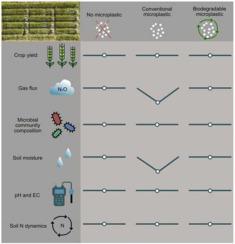Agriculture, Ecosystems & Environment ( IF 6.0 ) Pub Date : 2022-05-21 , DOI: 10.1016/j.agee.2022.108023 Lucy M. Greenfield , Martine Graf , Saravanan Rengaraj , Rafael Bargiela , Gwion Williams , Peter N. Golyshin , David R. Chadwick , Davey L. Jones

|
Microplastic contamination in agroecosystems is becoming more prevalent due to the direct use of plastics in agriculture (e.g., mulch films) and via contamination of amendments (e.g., compost, biosolids application). Long-term use of agricultural plastics and microplastic pollution could lead to soil degradation and reduced crop health due to the slow degradation of conventional plastics creating legacy plastic. Biodegradable plastics are more commonly being used, both domestically and in agriculture, to minimise plastic pollution due to their biodegradable nature. However, the influence of a biodegradable plastics on soil function at the field scale is largely unknown. We investigated the effect of conventional (polyethylene) and biodegradable (PHBV) microplastics on N2O emissions and soil biochemical processes in a field trial of winter barley. Microplastic was added to the soil at realistic levels (100 kg ha-1) for both conventional and biodegradable treatments. N2O emissions were measured throughout the growing season alongside key soil quality indicators (microbial community composition, ammonium, nitrate, moisture content, pH and EC). Overall, microplastic addition had no observable effect on crop yield, microbial communities or soil biochemical properties. Yet, we found cumulative N2O emissions were reduced by two-thirds following conventional microplastic addition compared to the no-plastic and biodegradable microplastic treatments. We believe this response is due to the lower soil moisture levels over the winter in the conventional microplastic treatment. Overall, the response of key soil parameters to microplastic addition show fewer negative effects to those seen in high dose laboratory mesocosm experiments. Thus, it is imperative that long-term field experiments at realistic dose rates be undertaken to quantify the real risk that microplastics pose to agroecosystem health.
中文翻译:

N2O 排放、微生物群落、土壤生化过程和冬季大麦生长对添加常规和可生物降解微塑料的现场响应
由于在农业中直接使用塑料(如地膜)和通过污染改良剂(如堆肥、生物固体应用),农业生态系统中的微塑料污染正变得越来越普遍。长期使用农业塑料和微塑料污染可能导致土壤退化并降低作物健康,因为传统塑料的缓慢降解会产生遗留塑料。可生物降解塑料更常用于家庭和农业,以尽量减少塑料污染,因为它们具有可生物降解的性质。然而,在田间尺度上,可生物降解塑料对土壤功能的影响在很大程度上是未知的。我们研究了传统(聚乙烯)和可生物降解(PHBV)微塑料对 N 2的影响冬大麦田间试验中的 O 排放和土壤生化过程。微塑料以实际水平(100 kg ha -1)添加到土壤中,用于常规和可生物降解的处理。在整个生长季节测量N 2 O 排放量以及关键土壤质量指标(微生物群落组成、铵、硝酸盐、水分含量、pH 和 EC)。总体而言,添加微塑料对作物产量、微生物群落或土壤生化特性没有明显影响。然而,我们发现累积的 N 2与无塑料和可生物降解的微塑料处理相比,传统微塑料添加后的 O 排放量减少了三分之二。我们认为这种反应是由于在传统的微塑料处理中冬季土壤水分含量较低。总体而言,关键土壤参数对微塑料添加的响应显示出比高剂量实验室中宇宙实验中看到的负面影响更少。因此,必须以实际剂量率进行长期现场实验,以量化微塑料对农业生态系统健康构成的真正风险。











































 京公网安备 11010802027423号
京公网安备 11010802027423号